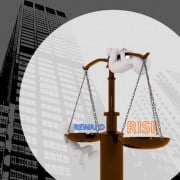Physical Occupancy Calculation Model for Real Estate (UPDATED MAY 2022)
As many of you know, I’m in the midst of moving my family from Milwaukee to Dallas, and quite frankly I’m getting sick of eating out and sleeping in hotel rooms. So what better way to unwind from hours of whining kids and tiresome travel, than to build a quick real estate Excel model for calculating the monthly physical occupancy percentage of your property!
Calculating Physical Occupancy (Warning: Beginner Stuff)
In real estate, there are generally two types of occupancy metrics that we care about: physical occupancy and economic occupancy. Economic occupancy refers to the percentage of potential gross income that a property achieves in a given period. For example, if the total potential rental revenue at a property in a given month was $100,000 but only $92,000 was earned, than the economic occupancy for that month is 92.0%.
Physical Occupancy on the other hand only looks at occupied space, regardless of the revenue earned from that space. So, if a building has 100,000 SF of rentable space and only 90,000 is occupied in a given month, than the physical occupancy rate in that month is 90.0%.
Economic vs. Physical Vacancy
Now keep in mind, some CRE professionals consider physical vacancy a somewhat meaningless metric, arguing that economic vacancy is all that matters because occupancy without revenue is meaningless. However, I assert economic vacancy without physical vacancy is equally as meaningless.
The health of a property is directly related to its physical occupancy. For instance, one strategy successfully employed by some of the best value add investors out there is to fill a building using aggressive inducements (e.g. free rent or other concessions) and then sell the property once momentum has picked up and rents have rolled to market. Early in such a strategy, economic vacancy will tell a very dreary story that could lead some to believe that the property is in trouble; when in reality, as measured by the physical vacancy metric, the strategy is working and the investment sound.
I believe a more complete story is told when you’re able to assess both the economic and physical vacancy of a property.
Model For Calculating Physical Occupancy
With that all said, I decided to build a model for quickly calculating the physical occupancy percentage per month of a property. The model can be downloaded by following the link in the box below.
The model allows for up to 100 tenants, and an analysis period of up to 360 months. You’ll need a current rent roll with lease start and end dates as well as an idea of what market downtime and lease lengths are. Just plug in each tenants name, the size of their space, the start and end date for their lease, and a downtime and market lease length assumptions for each tenant, and the Workbook will model the physical occupancy percentage for each month of your analysis period.
The cool thing about this model is that it outputs when a space is occupied, vacant, and when the precise month when a space is re-leased. This means the model could be adapted for use in forecasting out tenant improvements, leasing commissions, free rent, downtime, and other leasing costs.
If you have any questions or comments, please don’t hesitate to reach out.
The Physical Occupancy Calculation Model for Real Estate
- Calculates the monthly physical occupancy percentage of a property (or the inverse of the monthly physical vacancy of a property)
- Compatible with rent rolls up to 100 tenants
- Models 360 months
- Can easily be used to calculate other rollover events such as tenant improvements, leasing commissions, free rent, downtime, etc.
Compatibility
This version of the model is only compatible with Excel 2013, Excel 2016, and Excel 365
Download the Physical Occupancy Calculation Model for Real Estate
To make this model accessible to everyone, it is offered on a “Pay What You’re Able” basis with no minimum (enter $0 if you’d like) or maximum (your support helps keep the content coming – typical real estate development models sell for $100 – $300+ per license). Just enter a price together with an email address to send the download link to, and then click ‘Continue’. If you have any questions about our “Pay What You’re Able” program or why we offer our models on this basis, please reach out to either Mike or Spencer.
We regularly update the model (see version notes). Paid contributors to the model receive a new download link via email each time the model is updated.
Version Notes
v1.0
- Initial release









